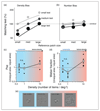Number As a Primary Perceptual Attribute: A Review
- PMID: 26562858
- PMCID: PMC5040510
- DOI: 10.1177/0301006615602599
Number As a Primary Perceptual Attribute: A Review
Abstract
Although humans are the only species to possess language-driven abstract mathematical capacities, we share with many other animals a nonverbal capacity for estimating quantities or numerosity. For some time, researchers have clearly differentiated between small numbers of items--less than about four--referred to as the subitizing range, and larger numbers, where counting or estimation is required. In this review, we examine more recent evidence suggesting a further division, between sets of items greater than the subitizing range, but sparse enough to be individuated as single items; and densely packed stimuli, where they crowd each other into what is better considered as a texture. These two different regimes are psychophysically discriminable in that they follow distinct psychophysical laws and show different dependencies on eccentricity and on luminance levels. But provided the elements are not too crowded (less than about two items per square degree in central vision, less in the periphery), there is little evidence that estimation of numerosity depends on mechanisms responsive to texture. The distinction is important, as the ability to discriminate numerosity, but not texture, correlates with formal maths skills.
Keywords: Numerosity; approximate number system; numerical cognition; subitizing; texture density.
© The Author(s) 2015.
Conflict of interest statement
Declaration of Conflicting Interests The author(s) declared no potential conflicts of interest with respect to the research, authorship, and/or publication of this article.
Figures










References
-
- Allik J, Tuulmets T. Occupancy model of perceived numerosity. Perception & Psychophysics. 1991;49:303–314. - PubMed
Publication types
MeSH terms
Grants and funding
LinkOut - more resources
Full Text Sources
Other Literature Sources
Research Materials

